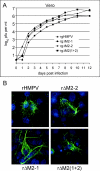Deletion of M2 gene open reading frames 1 and 2 of human metapneumovirus: effects on RNA synthesis, attenuation, and immunogenicity
- PMID: 15890897
- PMCID: PMC1112115
- DOI: 10.1128/JVI.79.11.6588-6597.2005
Deletion of M2 gene open reading frames 1 and 2 of human metapneumovirus: effects on RNA synthesis, attenuation, and immunogenicity
Abstract
The M2 gene of human metapneumovirus (HMPV) contains two overlapping open reading frames (ORFs), M2-1 and M2-2. The expression of separate M2-1 and M2-2 proteins from these ORFs was confirmed, and recombinant HMPVs were recovered in which expression of M2-1 and M2-2 was ablated individually or together [rdeltaM2-1, rdeltaM2-2, and rdeltaM2(1+2)]. Each M2 mutant virus directed efficient multicycle growth in Vero cells. The ability to recover HMPV lacking M2-1 contrasts with human respiratory syncytial virus, for which M2-1 is an essential transcription factor. Expression of the downstream HMPV M2-2 ORF was not reduced when translation of the upstream M2-1 ORF was silenced, indicating that it is initiated separately. The rdeltaM2-2 mutants exhibited a two- to fivefold increase in the accumulation of mRNA, normalized to the genome template, suggesting that M2-2 has a role in regulating RNA synthesis. Replication and immunogenicity were tested in hamsters. Animals infected intranasally with rdeltaM2-1 or rdeltaM2(1+2) did not have recoverable virus in the lungs or nasal turbinates on days 3 or 5 postinfection and did not develop HMPV-neutralizing serum antibodies or resistance to HMPV challenge. Thus, M2-1 appears to be essential for significant virus replication in vivo. In animals infected with rdeltaM2-2, virus was recovered from only 1 of 12 animals and only in the nasal turbinates on a single day. However, all of the animals developed a high titer of HMPV-neutralizing serum antibodies and were highly protected against challenge with wild-type HMPV. The HMPV rdeltaM2-2 virus is a promising and highly attenuated HMPV vaccine candidate.
Figures





References
-
- Ahmadian, G., P. Chambers, and A. J. Easton. 1999. Detection and characterization of proteins encoded by the second ORF of the M2 gene of pneumoviruses. J. Gen. Virol. 80:2011-2016. - PubMed
-
- Biacchesi, S., M. H. Skiadopoulos, G. Boivin, C. T. Hanson, B. R. Murphy, P. L. Collins, and U. J. Buchholz. 2003. Genetic diversity between human metapneumovirus subgroups. Virology 315:1-9. - PubMed
-
- Biacchesi, S., M. H. Skiadopoulos, K. C. Tran, B. R. Murphy, P. L. Collins, and U. J. Buchholz. 2004. Recovery of human metapneumovirus from cDNA: optimization of growth in vitro and expression of additional genes. Virology 321:247-259. - PubMed
MeSH terms
Substances
LinkOut - more resources
Full Text Sources
Other Literature Sources

